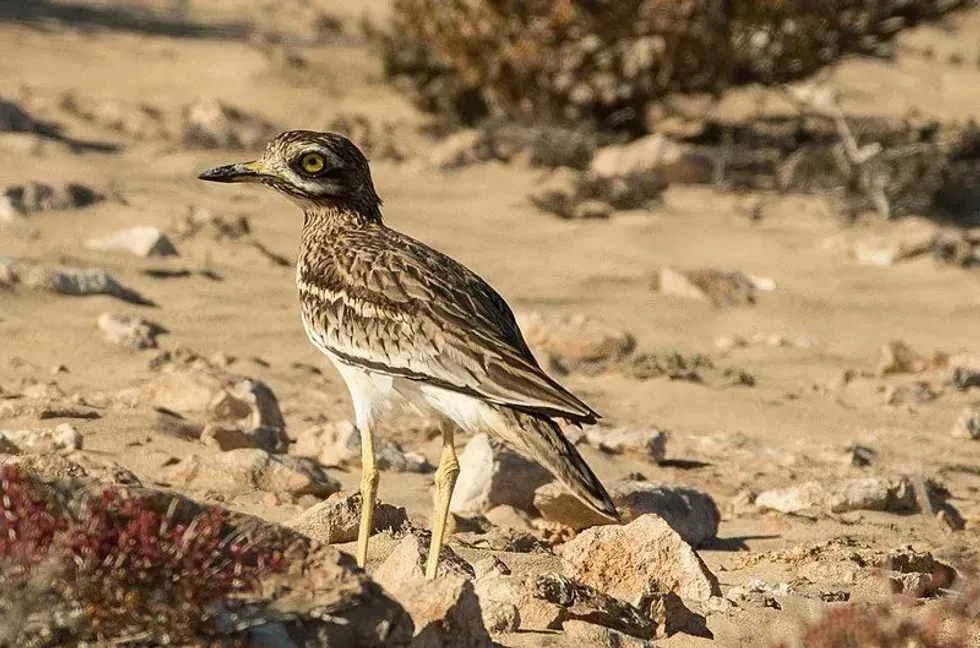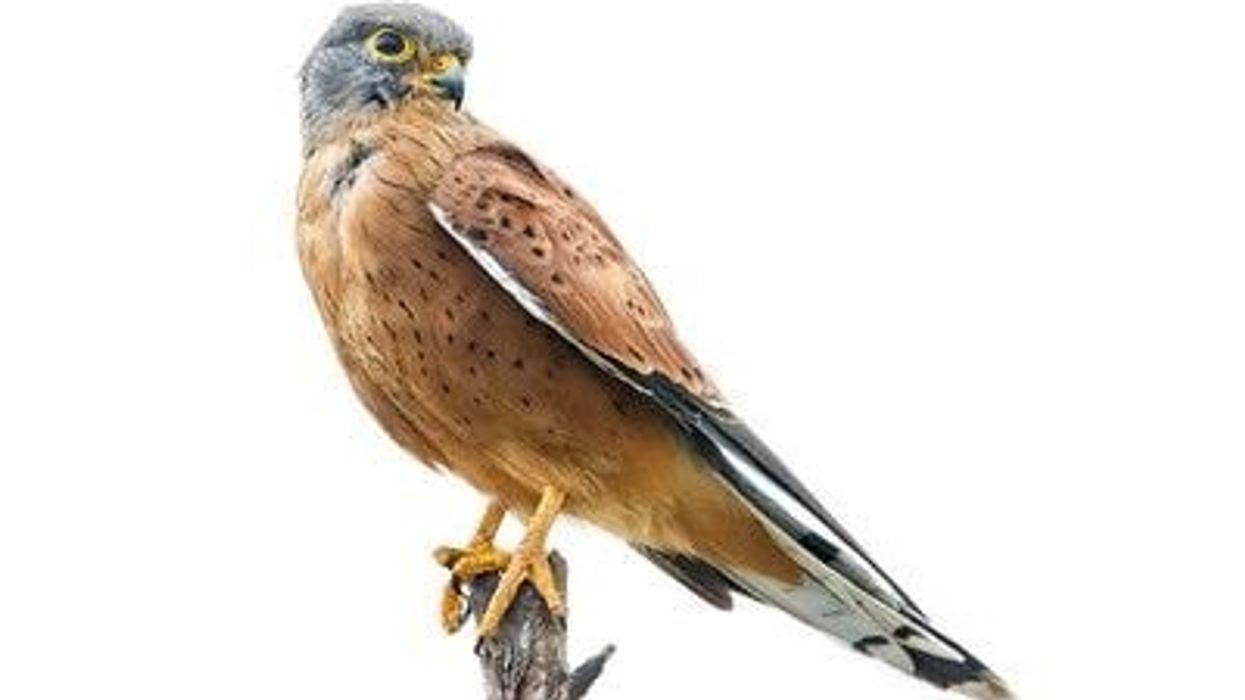Stone curlews, also called the Eurasian stone curlew or Eurasian thick-knee, are rare and come in the Least Concern conservation category. Their scientific name is Burhinus oedicnemus and they belong to the Animalia kingdom, Aves class, and Burhinidae family.
This small bird is very distinctive in appearance due to its strong yellow coloration on its beak, large yellow eyes, long thick yellow legs, and a sandy-brown plumage.
The Eurasian thick-knee is also known for its nocturnal trails and loud melodious sounds which can be heard during the night while they rest all day. Apart from its sound, this bird is considerably difficult to trace due to its camouflage appearance amongst the ground and can stand still (motionless) on the ground like a rock for hours.
Despite being classed as waders, these species usually prefer dry bare grounds and open habitats.
The Eurasian stone curlew bird occurs throughout the range of Southwest Asia, Europe, Australia, and North Africa. Further, they are quite faithful and generally return to the same partner to breed from year to year.
These birds have other species such as bush stone curlew, Indian stone curlew, water thick-knee, spotted thick-knee, double striped thick-knee, beach stone curlew, and more.
If you enjoy this article, check out house finch facts and barn owl facts.
Stone Curlew Interesting Facts
What type of animal is a stone curlew?
A stone curlew, also known as a Eurasian thick-knee, is a type of bird belonging to the Burhinidae family with yellow-colored bills, eyes, and legs. These birds have other species such as bush stone curlew, Indian stone curlew, water thick-knee, spotted thick-knee, double striped thick-knee, beach stone curlew, and more.
What class of animal does a stone curlew belong to?
The Eurasian stone curlew belongs to the Animalia kingdom, and Aves class.
How many stone curlews are there in the world?
Stone curlew's wildlife population is found to be more in France than elsewhere in Europe. In spite of the 10% decline in survival rate since the past 11 years, the population size of this species is very large, counting to approximately 360000-589999 across the globe.
Hence, stone curlews come in the Least Concern conservation status category as the wildlife do not face any near threat.
Where does a stone curlew live?
You will generally find the wildlife stone curlew (Burhinus oedicnemus) near the tropical and temperate parts and places like North Africa, Southwestern Asia, Australia, and Southern Europe. To get an easy glimpse of Eurasian thick-knee, you can visit the hides near the Norfolk Wildlife Trust Reserve of Weeting Heath, at the North Bradon.
What is a stone curlew's habitat?
Stone curlew's habitat is usually in the open, dry, bare places, rainforest fringes, open forests, and landscapes such as arable fields, grasslands, mangroves. This is because these kinds of places prove to be a good habitat for this species for camouflage and nesting.
Their breeding habitat period is from March- April and is also found in a highly modified environment. Which include urban gardens, golf courses, and grazing land away from civilization or noise.
Who do stone curlews live with?
Stone curlews live in flocks, especially when it is not their breeding period. These birds usually move in small groups during the day to ensure safety and keep an eye on danger.
These birds have other species such as bush stone curlew, Indian stone curlew, water thick knee, spotted thick knee, double striped thick knee, beach stone curlew, and more.
How long does a stone curlew live?
On average, the lifespan of an adult stone curlew is about 20-30 years. The UK holds the largest population size of this species.
How do they reproduce?
Stone curlews (Burhinus oedicnemus) mate for life and generally return back to the same nesting territory every year for breeding. Also, their nidification (nest-building) period is often linked to the climate they live in and usually, nidification happens in late spring and might also nidify from early February to late autumn.
Before breeding, during the courtship, the pair forms a strong bond. Usually, they have four breeding attempts if the early ones fail.
After which, the males scrape the ground to dig small holes for eggs. A few hours later the female decides in which hole she wants to lay eggs.
What is their conservation status?
The population of Eurasian thick-knee is decreasing and even then it comes under the Least Concern Conservation Status categorized by the International Union for Conservation of Nature. These birds have other species such as bush stone curlew, Indian stone curlew, water thick-knee, spotted thick-knee, double striped thick-knee, beach stone curlew, and more.
Stone Curlew Fun Facts
What do stone curlews look like?

The stone curlew (Burhinus oedicnemus) has a distinctive look with large bright yellow eyes like an owl, long yellow legs, and a small yellow-black bill. They have a sandy-brown plumage and a black and white wing bar that is clearly visible in flight.
How cute are they?
Stone curlews are quite cute as they have captivating yellow-colored eyes, legs, and beaks that make them look even more stunning. They are crow-sized and have a sandy brown-black plumage giving them excellent camouflage in sand and soils.
How do they communicate?
This bird is more often heard than seen due to its camouflage appearance. They communicate through sound as they have a loud and melodious call which is mostly audible at night.
How big is a stone curlew?
This exceptional and rare Burhinus oedicnemus is just 29 - 95 in (76 - 88 cm) long and 14.9-18 in (38 - 46 cm) tall similar to a size of a crow.
How fast can a stone curlew fly?
This bird rarely flies at night and most of the time it is motionless standing on bare lands and resting on the ground during the day.
How much does a stone curlew weigh?
The Eurasian stone curlew Burhinus weighs around 0.6-1.1 lb (290 -535 g).
What are the male and female names of the species?
The male and female species do not have separate names, rather they both are called stone curlews.
What would you call a baby stone curlew?
A baby stone curlew is called a chick.
What do they eat?
This bird preys on large invertebrates such as dung beetles or worms, insects, spiders, and at times on lizards, rodents, and frogs. The main predators of this bird include pythons, kookaburras, and quolls.
Are they dangerous?
As these birds are active mainly at night and rest during the day, they are not harmful or dangerous for humans. But, if they feel their chicks or eggs are in danger, they will spread their wings and hiss to chase away the predator.
Would they make a good pet?
Yes, they can be good pets.
Did you know...
The genus name Burhinus came from Greek. They are nocturnal birds like owls and do all of their activities and feeding at night. Because of this, they can be heard screaming at night.
The stone curlew's call
They make loud songs like sound at night such as a melodious 'curlee'. This is how the birds communicate and repeat the calls four to five times.
Can stone curlews fly?
Yes, these species can fly, but they usually don’t during the day as this is when they rest.
Here at Kidadl, we have carefully created lots of interesting family-friendly animal facts for everyone to discover! Learn more about some other bird from our gnatcatcher interesting facts or giant kingfisher surprising facts pages.
You can even occupy yourself at home by coloring in one of our free printable stone curlew coloring pages.










